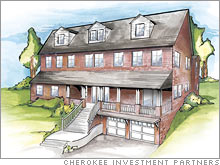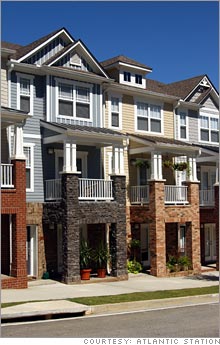|
Green building goes big
Developers are starting to incorporate environmentally sound building techniques in their multi-home projects.
NEW YORK (CNNMoney.com) - With oil piercing the $70-a-barrel barrier and natural-gas prices quadrupling since the late 1990s, the use of green construction in large-scale, multi-home developments is taking off. Helping the change is that green techniques and materials are increasingly becoming more affordable and "scalable," that is, they are capable of being made and installed in mass quantities.
Many developers are coming around. McGraw Hill Construction, in partnership with National Association of Home Builders (NAHB), reported a 20 percent jump last year in home builders focused on environmentally responsible construction. That should increase another 30 percent in 2006. Some 50 percent of all builders will produce at least some homes using green methods by 2010. But the percentage of green residences and commercial buildings constructed this year will still come to only about 2 percent of the total built, according to the report. However, that should rise to perhaps 10 percent by 2010. By then, between $29 billion and $57 billion a year will be spent on green building, up from $11 billion in 2006. Evidence that green building is starting to boom is not lacking. Taryn Holowka, of the United States Green Building Council, says that there are only about 500 buildings in the nation that qualify for the organization's LEED (leadership in energy and environmental design) status. But there are more than 4,000 under construction that will qualify. Originally, LEED only applied to commercial buildings, then to residential high rises. But the organization has a pilot program testing 500 single family homes for LEED certification. "The residential market is going to be huge," says Holowka. Energy savings is the reason. Holowka says, "Before, we were pushing LEED for its environmental benefits, but now the cost benefit is what's really driving interest." Already being built
Big green development projects have already arrived in some places. Atlantic Station is a LEED-qualified project on a brownfields in Atlanta, with commercial and residential buildings. It is, at more than 130 acres, so big it has its own zip code. Eventually 10,000 people will live there. Another initiative, this one by Cherokee Investment Partners, a firm that specializing in brownfields restoration projects, is a demonstration home being built outside its headquarters in Raleigh, North Carolina. The purpose is to show builders of large residential developments that they can incorporate green techniques, at little extra cost, into their projects. "We didn't want to tell our builders that they would have to build to a certain standard without providing the information they need," says Tom Darden, Cherokee's CEO. The home will use geo-source heat pumps, which utilize the constant underground 55 degree temperatures to both heat and cool homes, new kinds of insulation, innovative water systems and the like. Ultimately, it should use 50 percent less fossil fuels and water than conventional homes. It should also recycle or reuse 90 percent of organic waste. While the biggest reason for green building may be the bottom line, don't underestimate the satisfaction many Americans derive from being involved with these homes. The Melaver family in Georgia once owned a regional grocery store chain they sold to Krogers back in the 1990s, retaining ownership of some shopping and distribution centers. But they struggled to reconcile their progressive social philosophy, which included an interest in conservation, with their business, according to spokeswoman Lisa Lilienthal. They solved that dilemma by building LEED-qualified, mixed-use developments, including Abercorn Common in Savannah. That development has such green features as a 5 million gallon rainwater cistern, porous paving to prevent excessive storm runoff and preferred parking for hybrid vehicles. Building green has helped the family make a positive environmental impact and make profits while remaining true to their core values. What helps sell the concept is that green home design has gotten much more mainstream, according to architect Steve Novy, whose Colorado firm, Green Line Architects, specializes in green homes. "We can integrate green techniques with existing styles," he says. "As architects, we want to remove any stigma about buying green homes." Vanishing cost difference
When developers build multi-house projects they can realize economies of scale that lower costs substantially, so much so that green homes can cost barely more than comparable non-green ones. Calli Schmidt, director of environmental communications at NAHB, says an advantage of building green in bulk is that many of the expenses of green methods can be shared by multiple dwellings. Putting in one big geothermal heating system for 100 houses, for example, costs a lot less than putting in one system for each of 100 separate homes. And as green developments proliferate, the still small industries that make the materials it uses will grow. Manufacturers will realize efficiencies of scale, which will eventually lower prices all around. Novy estimates a much more energy efficient house may only cost about 10 percent more, yet save about half the energy costs and eventually pay for itself. Saving money always makes doing the right thing more palatable.
|
|


